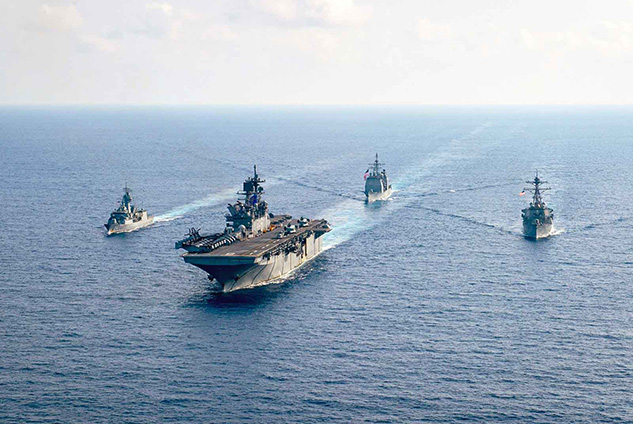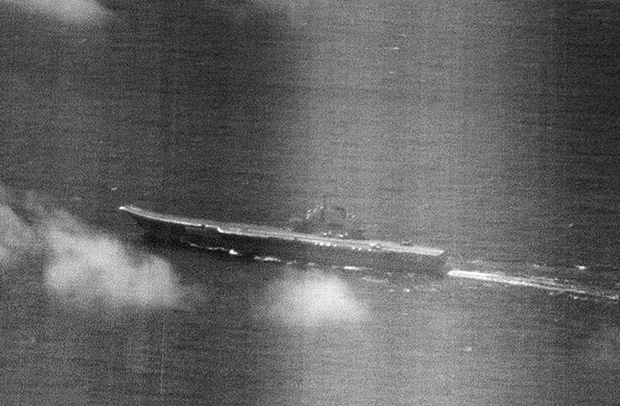Are Chinese and US Maneuvers in the Asia-Pacific a Precursor to War?

Source:U.S. Department of Defense
In spite of the global pandemic, the People's Liberation Army (PLA) has conducted various naval exercises in the past three months. Meanwhile, Beijing’s rhetoric towards Taiwan has become more belligerent. U.S. armed forces deployed in the Asia-Pacific region have since countered with a demonstration of force in waters bordering China’s territorial sea. Just what is the PLA’s game? Is it the precursor to a military invasion of Taiwan? Or is China taking advantage of the United States’ internal chaos to expand their foothold? Has the U.S. military might in the Asia-Pacific region been undermined?
Views
Are Chinese and US Maneuvers in the Asia-Pacific a Precursor to War?
By Ying-You Linweb only
Since the beginning of this year, the COVID-19 pandemic has been shaking up the established world order. The world economy, diplomatic ties, and international relations have all grown stagnant.
The same goes for China, except for one aspect. While governments around the world have had their hands full dealing with the outbreak, China’s armed forces have conducted a string of military exercises. Shortly after the Chinese New Year, the PLA conducted military drills in waters near Taiwan. They deployed a combination of the air force’s “long-distance ocean training”, and a naval strike group led by the aircraft carrier Liaoning.
On April 10th, China’s Global Times newspaper published an especially aggressive opinion piece. But on April 15th, former PLA senior colonel Yang Chengjun (楊承軍) spoke to Chinese media about the conditions of “seeking reunification by force”. He clearly stated that China will not take advantage of the pandemic to launch an offensive because the current cross-strait situation is not so dire as to warrant a military invasion. This seemed to be China’s way of signaling that their position had changed.
How can we make sense of the mixed messages put out by the Chinese media?
Is China's Media Strategy Different from Before?
First, it is important that we understand the nature of the Chinese media outlets delivering these messages. Even though most of China’s media are government mouthpieces, they answer to different branches of the government. This means that different media outlets have different agendas, and the messages they deliver can convey different intentions.
In the past, all of China’s rhetoric focused on reunification. Beijing eventually realized the error in this: It did not leave them a sufficient gray area to undertake adaptive policies. In recent years, China’s rhetoric has changed to match the “nature” and “interests” of individual departments.
For example, the PLA’s mission is clearly to prepare for war. But exchanges with Taiwan fall under the purview of the Taiwan Affairs Office of the State Council, or the United Front Work Department of the Central Committee of the Communist Party of China. Each department only says what it needs to further its own agenda. This gives Beijing the wiggle room necessary to proffer both carrot and stick in its dealings with Taiwan.
The Global Times plays the role of the hawk. Its rhetoric has always been belligerent. But the Taiwan Affairs Office has its own media channel: the news website taiwan.cn (中國台灣網). It often sends seemingly contradictory messages to achieve balance in China’s policy towards Taiwan.
Is U.S. Military Might Sapped by COVID-19?
Another topic picked up by various news agencies is whether the United States’ military presence in the Asia-Pacific region has been weakened by the virus outbreak. As the story goes, the COVID-19 pandemic on the USS Theodore Roosevelt may have left an opening for the PLA to make their move.
This conjecture, however, is most likely overly subjective.
First of all, the PLA’s actions were partially in response to the United States Armed Forces’ operations in the Asia-Pacific theater.
The U.S. has been very active in the Asia-Pacific since the Chinese New Year. Their operations have included naval vessels passing through the Taiwan Strait, drills in the South China Sea, and flybys by B-52 bombers and spy planes. At the end of April, China revealed that U.S. warships had been spotted near the disputed Paracel Islands. It was only natural for Beijing to respond to the Americans’ demonstration of military strength.
 Source: U.S. Department of Defense
Source: U.S. Department of Defense
Secondly, while it is true that the United States Navy’s strength has been sapped by the virus outbreak, in current projections of what an armed conflict between the two superpowers may look like, naval vessels are far from being the center of the picture.
The United States Armed Forces’ strategic planning in the Western Pacific Region is constantly shifting. Contemporary tactics differ wildly from the forward deployment strategy of the Cold War era. Force projection is the current focus. Carrier strike groups don’t need to be bogged down in specific regions to act as a deterrent. Rather, the key is mobile deployment.
With all this taken into account, what is the purpose of the PLA conducting drills during the epidemic?
China has always excelled at using a show of external strength to quell internal unrest. Beijing is facing a salvo of criticism, in part due to the Chinese people’s dissatisfaction with how the authorities and the central bureaucracy handled the virus crisis.
Secondly, Taiwan is shining on the world stage now for successfully battling the coronavirus. If Beijing does not react to this kind of exposure, the Chinese people may take it to mean the government has quietly accepted how Taiwan is presenting itself as a separate state. Inaction on the part of Beijing will be interpreted as a sign of weakness.
Though Beijing has made its position clear through the Ministry of Foreign Affairs’ spokesperson, nothing speaks louder or more forcefully than a high-profile military exercise. One of the unstated goals of the recent drills is to send a message to China’s own populace.
Having the Liaoning strike group sail into the Western Pacific Region and making a fuss about it fits well with Chinese propaganda: While other nations’ armed forces are suffering, it says, the Chinese military is still in tip-top shape.
Of course, there is more to the drills than just making a point. These military preparations are directly linked to Taiwan.
This is not the first time the Liaoning strike group has sailed into Taiwan’s eastern waters. We need to see this exercise in the light of all the other military drills to understand the narrative the PLA is staging in this military “mini-series”.
PLA fighter jets have conducted as many as six “long-distance ocean training” sessions in the Western Pacific Region during the last three months. The first drill was in late January, when military units moved into the Pacific from the Bashi Channel. Three more exercises were carried out in February, including two northbound excursions that passed through the Bashi Channel and Taiwan’s eastern waters.
March 16th was the first time the PLA conducted a nighttime joint exercise in Taiwan’s southwestern airspace. Another exercise was carried out in the same region on April 10th. At the same time, the Liaoning and its strike group passed through the Miyako Strait, Taiwan’s eastern waters, and the Bashi Channel, completing a clockwise circle of the island.
 Aerial photography released by Taiwan’s Ministry of National Defense shows the PLA aircraft carrier Liaoning passing through the Bashi Channel after wrapping up military drills in the South China Sea. (Source: Official Facebook fan page of the Ministry of National Defense spokesperson.)
Aerial photography released by Taiwan’s Ministry of National Defense shows the PLA aircraft carrier Liaoning passing through the Bashi Channel after wrapping up military drills in the South China Sea. (Source: Official Facebook fan page of the Ministry of National Defense spokesperson.)
In these drills, the air squadron formations were composed of different kinds of aircraft, including fighter jets, bombers, and early warning and control aircraft (electronic warfare aircraft). From this, we can see that, after the military reforms of 2015, the People's Liberation Army Air Force (PLAAF) has been rehearsing the operation of its new command and control system, as well as the Cooperative Engagement Capability (CEC) of its various airplanes. Its end goal is to conduct long-range operations designed to overwhelm the defenses of hostile forces (the United States and Taiwan). It also means the PLAAF’s role has changed from defending China’s airspace to a mixture of defense and offense.
Next, from the aircrafts’ flight coordinates and the distances covered by the naval vessels, we can gather that the PLA is likely conducting these drills to test the latest S-400 anti-aircraft missile systems purchased from Russia. We can compare the longest range covered by PLAAF planes with the anti-aircraft missiles’ effective range to deduce that the PLA is likely practicing for the eventuality of a coordinated lockdown of Taiwan’s territorial waters and airspace.
The latest military drills involved the air force, navy, and anti-aircraft missile systems. This means the PLA is gradually moving away from having individual branches of the armed forces carry out their own exercises. They are beginning to divide command based on the theater the armed forces will be operating in. That means a commander will have full control of the army, navy, air force, and the Rocket Forces (missile corps) in their region, allowing them to conduct joint military exercises.
In the future, these types of drills may occur more frequently in Taiwan’s surrounding waters and airspace. This is the challenge that Taiwan and other neighboring countries will soon be facing.
Whether cross-strait relations are good or strained, the PLA will always be a threat to Taiwan. The only recourse is to learn all there is to learn about them to improve our knowledge and analysis of the PLA. In this way, we can avoid being hoodwinked by rabble-rousers, or causing internal fear and panic due to a mistaken understanding of the opponent’s true strength.
If you want to avoid war, know thy enemy. Only then can we fight smart and achieve victory.
Have you read?
♦ ‘Today’s Hong Kong, Tomorrow’s Taiwan? Today’s Korea, Tomorrow’s Japan?’
♦ Chinese Energy Security and the South China Sea
Translated by Jack Chou
Edited by TC Lin
Uploaded by Judy Lu







